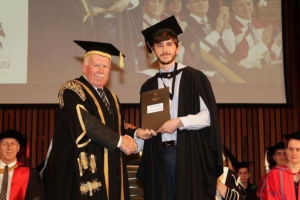Biography
David M. Harcombe graduated from The University Of Newcastle, Australia with a Bachelor of Engineering (Electrical) (Honours Class 1) with the University Medal in 2016. He is currently a PhD student within the Precision Mechatronics Lab, located in the School of Electrical Engineering and Computing, The University of Newcastle. His research areas include high-speed AFM and piezoelectric cantilever gas sensors.
Awards
- Winner of the 2017 Faculty of Built Environment and Engineering Poster Competition
- The University Medal (2017)
- AmpRes Industry Scholarship (2017)
- Australian Postgraduate Award (2016)
- Dean of Engineering’s Medal (2016)
- Dean’s Merit List (2013, 2014, 2015 and 2016)
- Faculty of Built Environment Electrical Engineering Summer Scholarships (2015 and 2016)
- Vice Chancellor’s Honours Scholarship (2015)
Education
The University of Newcastle, Callaghan Campus
Bachelor of Engineering (Electrical Engineering) with Honours Class 1 and The University Medal
Thesis title: High-speed estimation in Multifrequency Atomic Force Microscopy
Supervisor: Dr. Michael Ruppert
Teaching Experience
The University of Newcastle, Callaghan Campus
- ELEC1310 – Electircal Circuits I
Tutor and Lab Demonstrator (2015, 2016, 2017 and 2018)
- ELEC2320 – Electircal Circuits II
Tutor and Lab Demonstrator (2015 and 2019)
- ELEC3540 – Analog and Digital Communications
Tutor, Lab Demonstrator and Substitute Lecturer (2017)
- ELEC4210 – Electronics Design
Tutor and Lab Demonstrator (2018 and 2019)
- ENGG2440 – Modelling and Control
Tutor (2018)
Conferences Attended
- 2015 IEEE Multi-Conference on Systems and Control (MSC), September 21-23, Sydney, Australia.
- 2017 IEEE/ASME International Conference on Advanced Intelligent Mechatronics (AIM), July 3-7, Munich, Germany.
- 2017 World Congress of the International Federation of Automatic Control (IFAC), July 9-14, Toulouse, France.
- 2018 7th Multifrequency AFM Conference, April 18-20, Madrid, Spain.
- 2018 11th International Conference on Intelligent Robotics and Applications (ICIRA), August 9-11, Newcastle, Australia.
- 2019 International Conference on Manipulation, Automation and Robotics at Small Scales (MARSS), July 1-5, Helsinki, Finland.
- 2019 IEEE/ASME International Conference on Advanced Intelligent Mechatronics (AIM), July 8-12, Hong Kong.
Publications
2022
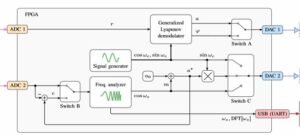
M. R. P. Ragazzon; S. Messineo; J. T. Gravdahl; D. M. Harcombe; M. G. Ruppert
The Generalized Lyapunov Demodulator: High-Bandwidth, Low-Noise Amplitude and Phase Estimation Journal Article
In: IEEE Open Journal of Control Systems, 2022.
@article{Ragazzon2022,
title = {The Generalized Lyapunov Demodulator: High-Bandwidth, Low-Noise Amplitude and Phase Estimation},
author = {M. R. P. Ragazzon and S. Messineo and J. T. Gravdahl and D. M. Harcombe and M. G. Ruppert},
doi = {10.1109/OJCSYS.2022.3181111},
year = {2022},
date = {2022-06-08},
urldate = {2022-06-08},
journal = {IEEE Open Journal of Control Systems},
abstract = {Effective demodulation of amplitude and phase is a requirement in a wide array of applications. Recent efforts have increased the demodulation performance, in particular, the Lyapunov demodulator allows bandwidths up to the carrier frequency of the signal. However, being inherently restricted to first-order filtering of the input signal, it is highly sensitive to frequency components outside its passband region. This makes it unsuitable for certain applications such as multifrequency atomic force microscopy (AFM). In this article, the structure of the Lyapunov demodulator is transformed to an equivalent form and generalized by exploiting the internal model principle. The resulting generalized Lyapunov demodulator structure allows for arbitrary filtering order and is easy to implement, requiring only a bandpass filter, a single integrator, and two nonlinear transformations. The generalized Lyapunov demodulator is implemented experimentally on a field-programmable gate array (FPGA). Then it is used for imaging in an AFM and benchmarked against the standard Lyapunov demodulator and the widely used lock-in amplifier. The lock-in amplifier achieves great noise attenuation capabilities and off-mode rejection at low bandwidths, whereas the standard Lyapunov demodulator is shown to be effective at high bandwidths. We demonstrate that the proposed demodulator combines the best from the two state-of-the-art demodulators, demonstrating high bandwidths, large off-mode rejection, and excellent noise attenuation simultaneously.},
keywords = {},
pubstate = {published},
tppubtype = {article}
}
2020
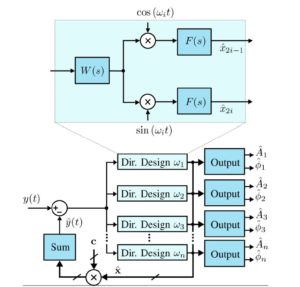
M. G. Ruppert; D. M. Harcombe; A. J. Fleming
Traditional and Novel Demodulators for Multifrequency Atomic Force Microscopy Conference
8th Multifrequency AFM Conference, Madrid, Spain, 2020.
@conference{Ruppert2020b,
title = {Traditional and Novel Demodulators for Multifrequency Atomic Force Microscopy},
author = {M. G. Ruppert and D. M. Harcombe and A. J. Fleming},
year = {2020},
date = {2020-10-27},
booktitle = {8th Multifrequency AFM Conference},
address = {Madrid, Spain},
abstract = {A number of multifrequency atomic force microscopy (MF-AFM) methods make use of the excitation and detection of higher harmonics of the fundamental frequency, higher flexural eigenmodes or intermodulation products generated by the non-linear tip-sample force [1]. Schematically, these methods are depicted in Figure 1(a) where the main difference is the resulting spacing and amplitude of the frequency components in the generated spectrum shown in Figure 1(b). Regardless of which particular MF-AFM method is employed, each requires a demodulator to obtain amplitude and phase to form observables for the characterization of nanomechanical sample information. Since high-speed non-synchronous demodulators such as the peak-hold method, peak detector and RMS-to-DC converter are incompatible with MF-AFM [2], there is a need for high-bandwidth demodulation techniques capable of estimating multiple frequencies at once while maintaining robustness against unwanted frequency components [3]. In this talk, the performance of traditional and recently proposed demodulators for multifrequency atomic force microscopy is assessed experimentally. The compared methods include the lock-in amplifier, coherent demodulator, Kalman filter, Lyapunov filter, and direct-design demodulator. Each method is implemented on a field-programmable gate array (FPGA) with a sampling rate of 1.5 MHz. The metrics for comparison include implementation complexity, the sensitivity to other frequency components and the magnitude of demodulation artifacts for a range of demodulator bandwidths. Performance differences are demonstrated through higher harmonic atomic force microscopy imaging.},
keywords = {},
pubstate = {published},
tppubtype = {conference}
}
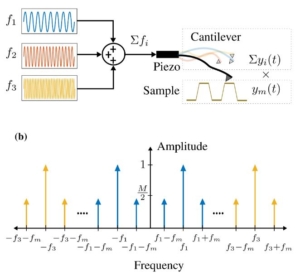
D. M. Harcombe; M. G. Ruppert; A. J. Fleming
A review of demodulation techniques for multifrequency atomic force microscopy Journal Article
In: Beilstein Journal of Nanotechnology, vol. 11, pp. 76-97, 2020, ISSN: 21904286.
@article{Harcombe2020,
title = {A review of demodulation techniques for multifrequency atomic force microscopy},
author = {D. M. Harcombe and M. G. Ruppert and A. J. Fleming},
editor = {T. Glatzel},
url = {https://www.precisionmechatronicslab.com/wp-content/uploads/2020/02/J20b-reducedSize.pdf},
doi = {doi:10.3762/bjnano.11.8},
issn = {21904286},
year = {2020},
date = {2020-01-07},
journal = {Beilstein Journal of Nanotechnology},
volume = {11},
pages = {76-97},
abstract = {This article compares the performance of traditional and recently proposed demodulators for multifrequency atomic force microscopy. The compared methods include the lock-in amplifier, coherent demodulator, Kalman filter, Lyapunov filter, and direct-design demodulator. Each method is implemented on a field-programmable gate array (FPGA) with a sampling rate of 1.5 MHz. The metrics for comparison include the sensitivity to other frequency components and the magnitude of demodulation artifacts for a range of demodulator bandwidths. Performance differences are demonstrated through higher harmonic atomic force microscopy imaging.},
keywords = {},
pubstate = {published},
tppubtype = {article}
}
2019
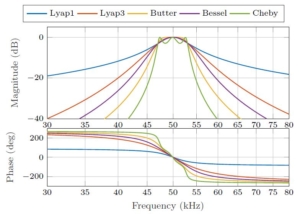
M. R. P. Ragazzon; S. Messineo; J. T. Gravdahl; D. M. Harcombe; M. G. Ruppert
Generalized Lyapunov Demodulator for Amplitude and Phase Estimation by the Internal Model Principle Proceedings Article
In: 8th IFAC Symposium on Mechatronic Systems, 2019, (accepted for publication).
@inproceedings{Ragazzon2019,
title = {Generalized Lyapunov Demodulator for Amplitude and Phase Estimation by the Internal Model Principle},
author = {M. R. P. Ragazzon and S. Messineo and J. T. Gravdahl and D. M. Harcombe and M. G. Ruppert},
year = {2019},
date = {2019-09-04},
booktitle = {8th IFAC Symposium on Mechatronic Systems},
abstract = {Effective demodulation of amplitude and phase is a requirement in a wide array of applications. Recent efforts have increased the demodulation performance, in particular, the Lyapunov demodulator allows bandwidths up to the carrier frequency of the signal. However, being inherently restricted to a single order filtering of the input signal, signal components outside its passband are not sufficiently attenuated for all applications, such as in multifrequency atomic force microscopy. In this article, the structure of the Lyapunov demodulator is transformed to an equivalent form, taking advantage of the internal model representation of the sinusoid to be tracked. A generalization of this formulation allows the application of standard filtering techniques in order to shape the characteristics of the demodulator, while retaining the perfect tracking condition provided by the internal model. Guidelines for the filter design are provided in order to achieve the desired characteristics, such as filtering order, tracking bandwidth, and transient performance. The resulting generalized Lyapunov demodulator structure is highly flexible, allows for direct employment of any standard filter type, is computationally simple, and easy to implement requiring only a bandpass filter, a single integrator, and two nonlinear transformations. Numerical results demonstrate the effectiveness of the approach, and provide a comparison of the various filters considered.},
note = {accepted for publication},
keywords = {},
pubstate = {published},
tppubtype = {inproceedings}
}
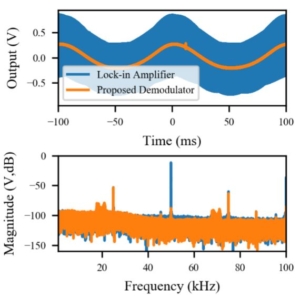
S. I. Moore; M. G. Ruppert; D. M. Harcombe; A. J. Fleming; Y. K. Yong
Design and Analysis of Low-Distortion Demodulators for Modulated Sensors Journal Article
In: IEEE/ASME Transactions on Mechatronics, vol. 24, no. 4, pp. 1861-1870, 2019, ISSN: 10834435, (This work was supported by the Australian Research Council Discovery Project DP170101813).
@article{Moore2019,
title = {Design and Analysis of Low-Distortion Demodulators for Modulated Sensors},
author = { S. I. Moore and M. G. Ruppert and D. M. Harcombe and A. J. Fleming and Y. K. Yong },
url = {https://www.precisionmechatronicslab.com/wp-content/uploads/2020/05/J19d-reduced.pdf},
doi = {10.1109/TMECH.2019.2928592},
issn = {10834435},
year = {2019},
date = {2019-07-17},
urldate = {2019-07-17},
journal = {IEEE/ASME Transactions on Mechatronics},
volume = {24},
number = {4},
pages = {1861-1870},
abstract = {System-based demodulators in the form of a Kalman and Lyapunov filter have been demonstrated to significantly outperform traditional demodulators, such as the lock-in amplifier, in bandwidth sensitive applications, for example high-speed atomic force microscopy. Building on their closed loop architecture, this article describes a broader class of high-speed closed-loop demodulators. The generic structure provides greater flexibility to independently control the bandwidth and sensitivity to out-of-band frequencies. A linear time-invariant description is derived which allows the utilization of linear control theory to design the demodulator. Experimental results on a nanopositioner with capacitive sensors demonstrate the realization of arbitrary demodulator dynamics while achieving excellent noise rejection.},
note = {This work was supported by the Australian Research Council Discovery Project DP170101813},
keywords = {},
pubstate = {published},
tppubtype = {article}
}
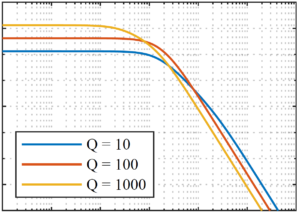
D. M. Harcombe; M. G. Ruppert; A. J. Fleming
Modeling and Noise Analysis of a Microcantilever-based Mass Sensor Proceedings Article
In: Int. Conference on Manipulation, Automation and Robotics at Small Scales (MARSS), Helsinki, Finland, 2019, ISSN: 978-1-7281-0948-0.
@inproceedings{Harcombe2019,
title = {Modeling and Noise Analysis of a Microcantilever-based Mass Sensor},
author = {D. M. Harcombe and M. G. Ruppert and A. J. Fleming},
url = {https://www.precisionmechatronicslab.com/wp-content/uploads/2021/02/C19c.pdf},
doi = {10.1109/MARSS.2019.8860982},
issn = {978-1-7281-0948-0},
year = {2019},
date = {2019-07-01},
booktitle = {Int. Conference on Manipulation, Automation and Robotics at Small Scales (MARSS)},
address = {Helsinki, Finland},
abstract = {Nanomechanical devices have the potential for practical applications as mass sensors. In microcantilever based sensing, resonance frequency shifts are tracked by a
phase-locked loop (PLL) in-order to monitor mass adsorption. A major challenge in minimizing the mass detection limit comes from the noise present in the system due to thermal, sensor and oscillator noise. There is numerical difficulty in simulating PLLs, as both low frequency phase estimates and high frequency mixing products need to be captured resulting in a stiff problem. By using linear system-theoretic modeling an in-depth analysis of the system is able to be conducted overcoming this issue. This provides insight into individual noise source propagation, dominant noise sources and possible ways to reduce their effects. The developed model is verified in simulation against the non-linear PLL, with each achieving low picogram sensitivity for a 100 Hz loop bandwidth and realistically modeled noise sources.},
keywords = {},
pubstate = {published},
tppubtype = {inproceedings}
}
phase-locked loop (PLL) in-order to monitor mass adsorption. A major challenge in minimizing the mass detection limit comes from the noise present in the system due to thermal, sensor and oscillator noise. There is numerical difficulty in simulating PLLs, as both low frequency phase estimates and high frequency mixing products need to be captured resulting in a stiff problem. By using linear system-theoretic modeling an in-depth analysis of the system is able to be conducted overcoming this issue. This provides insight into individual noise source propagation, dominant noise sources and possible ways to reduce their effects. The developed model is verified in simulation against the non-linear PLL, with each achieving low picogram sensitivity for a 100 Hz loop bandwidth and realistically modeled noise sources.
2018
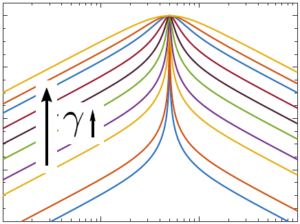
M. G. Ruppert; D. M. Harcombe; S. I. Moore; A. J. Fleming
Direct Design of Closed-loop Demodulators for Amplitude Modulation Atomic Force Microscopy Proceedings Article
In: American Control Conference, Milwaukee, WI, 2018.
@inproceedings{C18b,
title = {Direct Design of Closed-loop Demodulators for Amplitude Modulation Atomic Force Microscopy},
author = {M. G. Ruppert and D. M. Harcombe and S. I. Moore and A. J. Fleming},
url = {https://www.precisionmechatronicslab.com/wp-content/uploads/2021/02/C18b.pdf},
doi = {10.23919/ACC.2018.8430896},
year = {2018},
date = {2018-06-27},
booktitle = {American Control Conference},
address = {Milwaukee, WI},
abstract = {A fundamental component of the z-axis feedback loop in amplitude modulation atomic force microscopy is the demodulator. It dictates both bandwidth and noise in the amplitude and phase estimate of the cantilever deflection signal. In this paper, we derive a linear time-invariant model of a closedloop demodulator with user definable tracking bandwidth and sensitivity to other frequency components. A direct demodulator design method is proposed based on the reformulation of the Lyapunov filter as a modulated-demodulated controller in closed loop with a unity plant. Simulation and experimental results for a higher order Lyapunov filter as well as Butterworth and Chebyshev type demodulators are presented.},
keywords = {},
pubstate = {published},
tppubtype = {inproceedings}
}
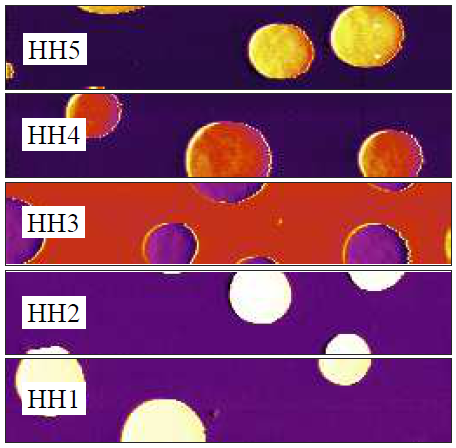
D. M. Harcombe; M. G. Ruppert; M. R. P. Ragazzon; A. J. Fleming
Lyapunov Estimation for High-Speed Demodulation in Multifrequency Atomic Force Microscopy Journal Article
In: Beilstein Journal of Nanotechnology, vol. 9, pp. 490-498, 2018, ISSN: 21904286.
@article{J18c,
title = {Lyapunov Estimation for High-Speed Demodulation in Multifrequency Atomic Force Microscopy},
author = {D. M. Harcombe and M. G. Ruppert and M. R. P. Ragazzon and A. J. Fleming},
url = {https://www.precisionmechatronicslab.com/wp-content/uploads/2018/02/J18c.pdf},
doi = {10.3762/bjnano.9.47},
issn = {21904286},
year = {2018},
date = {2018-02-28},
journal = {Beilstein Journal of Nanotechnology},
volume = {9},
pages = {490-498},
abstract = {An important issue in the emerging field of multifrequency atomic force microscopy (MF-AFM) is the accurate and fast demodulation of the cantilever-tip deflection signal. As this signal consists of multiple frequency components and noise processes, a lock-in amplifier is typically employed for its narrowband response. However, this demodulator suffers inherent bandwidth limitations as high frequency mixing products must be filtered out and several must be operated in parallel. Many MF-AFM methods require amplitude and phase demodulation at multiple frequencies of interest, enabling both z-axis feedback and phase contrast imaging to be achieved. This article proposes a model-based multifrequency Lyapunov filter implemented on a Field Programmable Gate Array (FPGA) for high-speed MF-AFM demodulation. System descriptions and simulations are verified by experimental results demonstrating high tracking bandwidths, strong off-mode rejection and minor sensitivity to cross-coupling effects. Additionally, a five-frequency system operating at 3.5MHz is implemented for higher harmonic amplitude and phase imaging up to 1MHz.},
keywords = {},
pubstate = {published},
tppubtype = {article}
}
2017
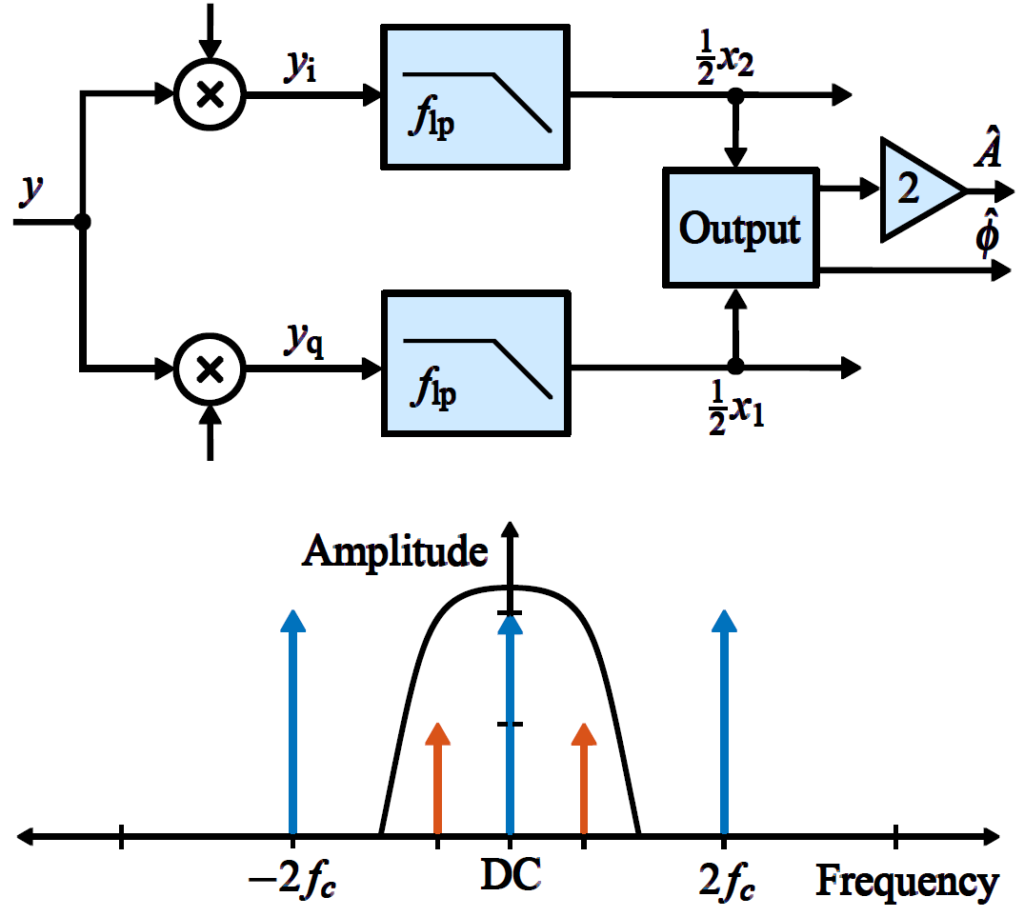
M. G. Ruppert; D. M. Harcombe; M. R. P. Ragazzon; S. O. R. Moheimani; A. J. Fleming
A Review of Demodulation Techniques for Amplitude Modulation Atomic Force Microscopy Journal Article
In: Bellstein Journal of Nanotechnology, vol. 8, pp. 1407–1426, 2017.
@article{J17h,
title = {A Review of Demodulation Techniques for Amplitude Modulation Atomic Force Microscopy},
author = {M. G. Ruppert and D. M. Harcombe and M. R. P. Ragazzon and S. O. R. Moheimani and A. J. Fleming},
url = {https://www.precisionmechatronicslab.com/wp-content/uploads/2020/08/2190-4286-8-142.pdf},
doi = {10.3762/bjnano.8.142},
year = {2017},
date = {2017-09-01},
journal = {Bellstein Journal of Nanotechnology},
volume = {8},
pages = {1407–1426},
abstract = {In this review paper, traditional and novel demodulation methods applicable to amplitude modulation atomic force microscopy are implemented on a widely used digital processing system. As a crucial bandwidth-limiting component in the z-axis feedback loop of an atomic force microscope, the purpose of the demodulator is to obtain estimates of amplitude and phase of the cantilever deflection signal in the presence of sensor noise or additional distinct frequency components. Specifically for modern multifrequency techniques, where higher harmonic and/or higher eigenmode contributions are present in the oscillation signal, the fidelity of the estimates obtained from some demodulation techniques is not guaranteed. To enable a rigorous comparison, the performance metrics tracking bandwidth, implementation complexity and sensitivity to other frequency components are experimentally evaluated for each method. Finally, the significance of an adequate demodulator bandwidth is highlighted during high-speed tapping-mode AFM experiments in constant height mode.},
keywords = {},
pubstate = {published},
tppubtype = {article}
}
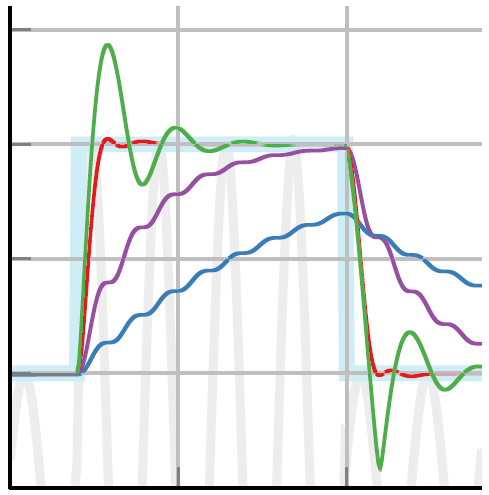
M. R. P. Ragazzon; M. G. Ruppert; D. M. Harcombe; A. J. Fleming; J. T. Gravdahl
Lyapunov Estimator for High-Speed Demodulation in Dynamic Mode Atomic Force Microscopy Journal Article
In: IEEE Transactions on Control Systems Technology, vol. 26, no. 2, pp. 765-772, 2017.
@article{J17e,
title = {Lyapunov Estimator for High-Speed Demodulation in Dynamic Mode Atomic Force Microscopy},
author = {M. R. P. Ragazzon and M. G. Ruppert and D. M. Harcombe and A. J. Fleming and J. T. Gravdahl},
url = {https://www.precisionmechatronicslab.com/wp-content/uploads/2017/09/J17e.pdf},
year = {2017},
date = {2017-08-01},
journal = {IEEE Transactions on Control Systems Technology},
volume = {26},
number = {2},
pages = {765-772},
abstract = {In dynamic mode atomic force microscopy (AFM), the imaging bandwidth is governed by the slowest component in the open-loop chain consisting of the vertical actuator, cantilever and demodulator. While the common demodulation method is to use a lock-in amplifier (LIA), its performance is ultimately bounded by the bandwidth of the post-mixing low-pass filters. This article proposes an amplitude and phase estimation method based on a strictly positive real Lyapunov design approach. The estimator is designed to be of low complexity while allowing for high bandwidth. Additionally, suitable gains for high performance are suggested such that no tuning is necessary. The Lyapunov estimator is experimentally implemented for amplitude demodulation and shown to surpass the LIA in terms of tracking bandwidth and noise performance. High-speed AFM images are presented to corroborate the results.},
keywords = {},
pubstate = {published},
tppubtype = {article}
}
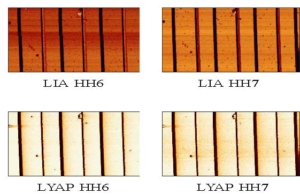
D. M. Harcombe; M. G. Ruppert; A. J. Fleming
Higher-harmonic AFM Imaging with a High-Bandwidth Multifrequency Lyapunov Filter Proceedings Article
In: IEEE/ASME Advanced Intelligent Mechatronics (AIM), Munich, Germany, 2017.
@inproceedings{C17e,
title = {Higher-harmonic AFM Imaging with a High-Bandwidth Multifrequency Lyapunov Filter},
author = {D. M. Harcombe and M. G. Ruppert and A. J. Fleming},
year = {2017},
date = {2017-07-03},
booktitle = {IEEE/ASME Advanced Intelligent Mechatronics (AIM)},
address = {Munich, Germany},
abstract = {A major difficulty in multifrequency atomic force microscopy (MF-AFM) is the accurate estimation of amplitude and phase at multiple frequencies for both z-axis feedback and material contrast imaging. Typically a lock-in amplifier is chosen as it is both narrowband and simple to implement. However, it inherently suffers drawbacks including a limited bandwidth due to post mixing low-pass filters and the necessity for multiple to be operated in parallel for MF-AFM. This paper proposes a multifrequency demodulator in the form of a modelbased Lyapunov filter implemented on a Field Programmable Gate Array (FPGA). System modelling and simulations are verified by experimental results demonstrating high tracking bandwidth and off-mode rejection at modelled frequencies. Additionally, AFM scans with a five-frequency-based system are presented wherein higher harmonic imaging is performed up to 1 MHz.},
keywords = {},
pubstate = {published},
tppubtype = {inproceedings}
}
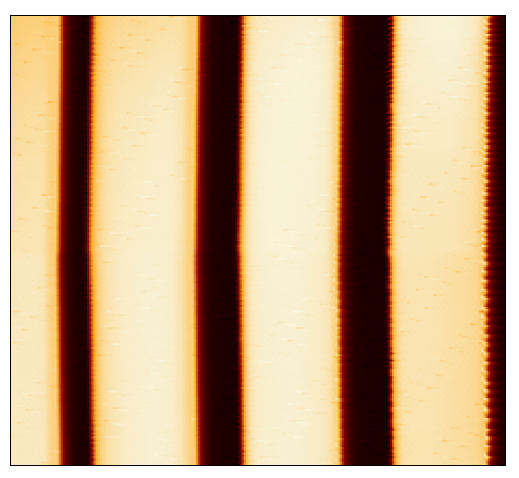
M. G. Ruppert; D. M. Harcombe; M. R. P. Ragazzon; S. O. R. Moheimani; A. J. Fleming
Frequency Domain Analysis of Robust Demodulators for High-Speed Atomic Force Microscopy Proceedings Article
In: American Control Conference, Seattle, WA, 2017.
@inproceedings{C17b,
title = {Frequency Domain Analysis of Robust Demodulators for High-Speed Atomic Force Microscopy},
author = {M. G. Ruppert and D. M. Harcombe and M. R. P. Ragazzon and S. O. R. Moheimani and A. J. Fleming},
year = {2017},
date = {2017-05-01},
booktitle = {American Control Conference},
address = {Seattle, WA},
abstract = {A fundamental but often overlooked component in the z-axis feedback loop of the atomic force microscope (AFM) operated in dynamic mode is the demodulator. It’s purpose is to obtain a preferably fast and low-noise estimate of amplitude and phase of the cantilever deflection signal in the presence of sensor noise and additional distinct frequency components. In this paper, we implement both traditional and recently developed robust methods on a labVIEW digital processing system and rigorously compare these techniques experimentally in terms of measurement bandwidth, implementation complexity and robustness to noise. We conclude with showing high-speed tapping-mode AFM images in constant height, highlighting the significance of an adequate demodulator bandwidth.},
keywords = {},
pubstate = {published},
tppubtype = {inproceedings}
}
2016
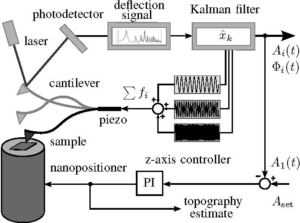
M. G. Ruppert; D. M. Harcombe; S. O. R. Moheimani
High-Bandwidth Demodulation in MF-AFM: A Kalman Filtering Approach Journal Article
In: IEEE/ASME Transactions on Mechatronics, vol. 21, no. 6, pp. 2705-2715, 2016.
@article{Ruppert2016,
title = {High-Bandwidth Demodulation in MF-AFM: A Kalman Filtering Approach},
author = {M. G. Ruppert and D. M. Harcombe and S. O. R. Moheimani},
doi = {10.1109/TMECH.2016.2574640},
year = {2016},
date = {2016-12-01},
journal = {IEEE/ASME Transactions on Mechatronics},
volume = {21},
number = {6},
pages = {2705-2715},
abstract = {Emerging multifrequency atomic force microscopy (MF-AFM) methods rely on coherent demodulation of the cantilever deflection signal at multiple frequencies. These measurements are needed in order to close the z-axis feedback loop and to acquire complementary information on the tip-sample interaction. While the common method is to use a lock-in amplifier capable of recovering low-level signals from noisy backgrounds, its performance is ultimately bounded by the bandwidth of the low-pass filters. In light of the demand for constantly increasing imaging speeds while providing multifrequency flexibility, we propose to estimate the in-phase and quadrature components with a linear time-varying Kalman filter. The chosen representation allows for an efficient high-bandwidth implementation on a Field Programmable Gate Array (FPGA). Tracking bandwidth and noise performance are verified experimentally and trimodal AFM results on a two-component polymer sample highlight the applicability of the proposed method for MF-AFM.},
keywords = {},
pubstate = {published},
tppubtype = {article}
}
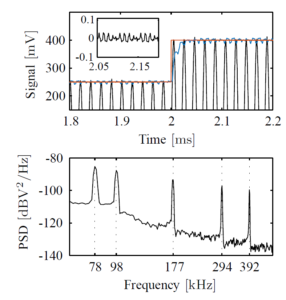
M. G. Ruppert; D. M. Harcombe; S. O. R. Moheimani
State estimation for high-speed multifrequency atomic force microscopy Proceedings Article
In: American Control Conference, pp. 2617-2622, Boston, MA, USA, 2016.
@inproceedings{Ruppert2016b,
title = {State estimation for high-speed multifrequency atomic force microscopy},
author = {M. G. Ruppert and D. M. Harcombe and S. O. R. Moheimani},
doi = {10.1109/ACC.2016.7525311},
year = {2016},
date = {2016-07-01},
booktitle = {American Control Conference},
pages = {2617-2622},
address = {Boston, MA, USA},
abstract = {A fundamental component in the z-axis feedback loop of an atomic force microscope (AFM) operated in dynamic mode is the lock-in amplifier to obtain amplitude and phase of the high-frequency cantilever deflection signal. While this narrowband demodulation technique is capable of filtering noise far away from the carrier and modulation frequency, its performance is ultimately bounded by the bandwidth of its low-pass filter which is employed to suppress the frequency component at twice the carrier frequency. Moreover, multiple eigenmodes and higher harmonics are used for imaging in modern multifrequency AFMs, which necessitates multiple lock-in amplifiers to recover the respective amplitude and phase information. We propose to estimate amplitude and phase of multiple frequency components with a linear time-varying Kalman filter which allows for an efficient implementation on a Field Programmable Gate Array (FPGA). While experimental results for the single mode case have already proven to increase the imaging bandwidth in tapping-mode AFM, multifrequency simulations promise further improvement in imaging flexibility. },
keywords = {},
pubstate = {published},
tppubtype = {inproceedings}
}


